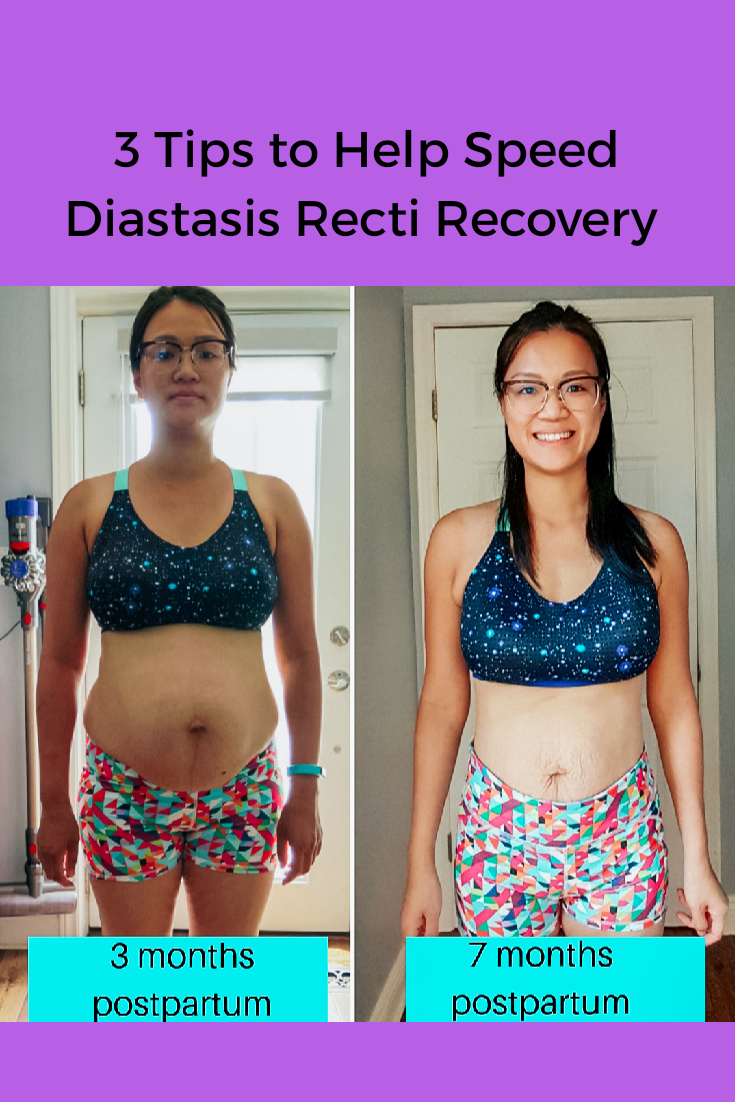Many women, either during or following pregnancy, will suffer from the condition known as diastasis recti. This is where the rectus abdominus, or the “six-pack” muscles that meet and run the midline of your stomach, will begin to think.
The connective tissue in this area, the linea alba, is what holds the rectus muscles together on both the right and the left. Over time, as the abdomen is stretched, this thinning will cause the tissue to slack, resulting in the left and right muscles distancing themselves from each other.

This condition is prevalent and commonplace during pregnancy, as the uterine muscles of the abdomen stretch, which then accommodates the growth of your baby. A study recently showed that as many as 60 percent of pregnant women might experience this condition during pregnancy or postpartum.
The Symptoms
The most commonly experienced diastasis recti symptoms are the presentation of a pooch or bulge in the area of your stomach.
This bulge may become more noticeable when you strain or contract the muscles of your abdomen. Other symptoms may also include lower back pain, poor posture, constipation, and bloating feeling.
There are usually no noticeable signs of your abdomen’s muscles slacking and distancing until your second or third trimester. At this time, many women report that they notice a bulge, or ridge, on their belly.
This bulge can appear either above, or below, the bellybutton, and is usually most noticeable when you perform movements that require the use of your abdominal muscles, such as standing, sitting up, or lying down.
Now that we know exactly what diastasis recti is and what the symptoms are let’s take a look at three steps to get you moving towards recovery.
Tips For Recovery
1. Breathing
There are two types of breathing exercises that you can perform to aid in your recovery from DR.
One is more of an imaginary exercise, in which you are using your mind to bring your abdominal muscles back to the middle.
Position yourself by lying on your back and then focusing on one of three areas at a time: the area above the belly button, the area of the belly button, and finally, the area of the hip bones.
Imagine that you are drawing the sides of your body, your left and right side, to the middle of each of the areas above, and hold this for 10 seconds, making sure that you exhale while you are holding. This exercise is essential, no matter how severe your DR may be.
Next is the process of deep breathing. Many have asked what the point is of deep breathing and just what is the role it plays in diastasis.
Although this is a topic that I dive into deeply with my one on one coaching, I want to take a moment to share the mistake that I made in the past.
This form of breathing was responsible for my DR recovery plateau lasting as long as it did. When I worked to learn how to breathe correctly, I was then able to not only efficiently use but train my core, which resulted in an improvement of the depth of my DR, with the added protection of my spine and the strengthening of my pelvic floor.
The breathing mistake I am referring to here is the breathing into my belly. Now, I know this may sound strange, but stay with me here. Looking at yourself in the mirror, take a deep inhaling breath. Where do you see that breath going? You will notice that your belly is protruding and distending each time you inhale.
I found that I was belly breathing for a long time before I realized that I was breathing wrong. When we breathe, it naturally wants to go to our stomach, and those moms with severe DR will experience this as well due to the muscles of the abdomen being stretched and thinned, and, as a result, do not offer much in the way of support.
So, the question now is—how do you breathe correctly?
Start by removing your tight bra and your tight pants. Lie down on the floor, bending your legs and relaxing your shoulders.
Your back is to be touching the floor.
Watch yourself with a mirror, and proceed to inhale deeply. When inhaling, attempt to send this breath equally to the sides of your ribs, the back, chest, and belly areas.
2. Nutrition
Our abdominal muscles consist of collagen fiber, and as such proper nutrition is crucial to the healing process. We need to intake the appropriate types of foods, as they will play an essential role in bringing back the elasticity of our abdominal muscles
The key this–a balanced diet. Some useful tips for this include:
Make sure that you eat a variety of foods, including fruit, vegetables, grains, proteins, and dairy.
Drink plenty of liquids, at least 6-10 glasses a day, switching it up between water, milk, and fruit juices.
Eat high protein foods such as milk, cheese, yogurt, meat, and beans.
Make sure to eat your fruits and vegetables.
Lose weight safely as the loss of weight too quickly after giving birth can affect your supply of breast milk.
Supplement with prenatal vitamins if you are breastfeeding.
Limit the eating of junk food such as soda pop, cookies, and French fries, to name a few.
Also, make sure to avoid the consumption of alcohol and caffeine.

3. Strengthening
The amount of strengthening needed for your core will depend on how severe your DR currently is and the stage you are in your journey.
Beginner
This is the stage of most new moms, which not only didn’t know they had severe DR but didn’t do anything about it. Typically, at this stage, they have not consulted a professional.
Intermediate
You have been practicing and engaging a few types of diastasis exercises, and even been able to do some low impact working out, but the mommy pooch still persists.
Advanced
You have pretty much done all you can do at this stage, but you have plateaued, and the mommy pooch just won’t go away.
The Take-Away
As with any related medical condition, it is advised that you check with your physician to determine just how severe your situation may be.
Everyone is different, and as such, our bodies will react differently to a change in diet or the addition of an exercise routine. The idea is to engage your transversus abdominis muscles—the deepest layer of your abdominal muscles) through the practice of activation throughout each day.



